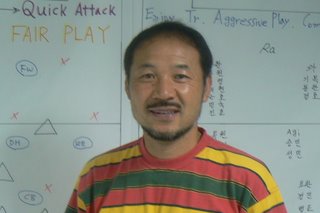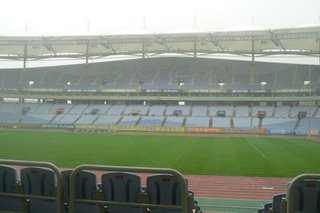Jang Woe-Ryeong
 |
| Jang Woe-Ryeong |
The monsoon season of 2006 was the wettest and longest in the living memory of even the oldest South Koreans. The sight of the rain cascading off the roof and on to the empty seats at the home of the second-youngest Korean professional team was a depressing testament to that.
Some of those 52, 179 blue plastic chairs had been occupied the night before as Incheon United drew 0-0 with Daegu. It was the latest blank for United in a 2006 that, for the home team, has seemed as gloomy and interminable as the month of July and the bowels of the World Cup arena had the stale air of a dank basement. The next season – weather or football – can't come quickly enough.
Incheon's coach Jang Woe-ryeong could be found in his basement office, a large room that provided a glimpse of the sodden pitch and while it had the feel of a boxer's locker room; it was adorned with paraphernalia from another sport.
The 47 year-old is one of the most recognizable figures in Korean football, fans are accustomed to seeing him standing in front of the dug-out sporting his trademark white baseball cap. Without it he still looks youthful and cheery despite the team's mediocre tenth place (out of 14) in the first half of the K-League.
"Our pre-season was so short and we had little time to train together," he explained. "The foreign players arrived late. We chose to train in China but it was a mistake as many players were injured at the time."
The K-League is separated into two stages, the first finished in May, with a gap of three months between. During that time, clubs amuse themselves with the much-maligned Hauzen Cup competition – Incheon finished last.
"We didn't care much about the competition," shrugged Jang. "The reason we participated is that it gives a chance for our young players and older players to improve their teamwork."
 |
| Korean soccer |
The struggle in 2006 has come as a disappointment after an impressive 2005 season in which the west coast club finished as runners-up. That feat was all the more impressive because the club came into existence only in 2004.
It seems longer but it is only 30 months since United burst into life in a blaze of publicity and excitement. Silver-haired German coach Werner Lorant arrived to oversee a squad that looked more than useful especially with the addition of Turkish international star Alpay.
Three months later as the K-League's first stage ended with Incheon in last place. Alpay and Lorant soon disappeared. Jang was the assistant during that turbulent baptism, returning to Korea after five years coaching in Japan.
"There were many new players," he recalled, "both foreign and Korean and naturally they had communication problems. At first, even the Korean players had problems communicating with each other under the new coach."
The capture of the 2002 World Cup star and Premier League regular Alpay was a real coup for the club. He was not only the star player at Incheon but the biggest name in the K-League. According to Jang, his talent matched his reputation but …"he lacked a little professionalism. He is a good player…but he made no attempt to become part of the team."
In the summer of 2004, Jang became coach. His philosophy was simple. Incheon would be united in more than just name.
"We focused on improving our communication," said Jang. "Most Korean players lack communication skills on the field, they don't talk much to each other… they go through school and university where there's a strict hierarchy between older and younger players."
The situation immediately improved. The second stage saw the team finish fourth.
In 2005, United collected the most overall points in the season, earning a place in the championship play-offs which saw defeat in the final at the hands of ulsan Hyundai Horang-i.
Consequently, expectations were high at the start of 2006. Prior to its commencement, the coach talked of the importance of qualifying for the Asian Champions League.
"Joining the Champions League would be good for the young players, it would be a good learning experience for them.
"It's a big goal but bigger goals are better than small ones."
In the meantime, Jang is encouraging his young players to learn from the foreigners that make their way to the Munhak Stadium. Unlike most other K-League teams with their Brazilian fancies, Incheon imports players from the Balkans – Serbs and Croats have featured strongly in the infant years of the club. In the past weeks, two international players have arrived – one Macedonian the other Bosnian.
"The chairman has many contacts and knowledge in that region," smiled the coach by way of explanation. "I also have experience in working with East Europeans players. Compared to Brazilians, they are good at communicating and don't make any problems."
One of the signings debuted the night before, 'satisfactorily' according to Jang. For the sake of Incheon fans, the two need to settle in quickly as the second stage of the K-League kicks off on August 23.
All football fans in the country are hoping for a better second stage than first as the K-League is increasingly perceived as a competition with a number of fundamental problems.
"There are many ways to improve the league," says Jang, sipping his green tea which matches part of his bright t-shirt. "The KFA, coaches and players need to open channels of communication."
I asked about the frantic schedule that the K-League inflicts on its members.
"The administration has made the problem and needs to solve it. When it makes the schedule, it needs to focus on the K-League only but that doesn't happen. It focuses on the needs of the national team."
"Footballers need to train and play and we need to analyze the results. Hopefully, in the next game players can use what they have learned. If we have another game so soon then we have no time to do anything."
Improving things is what Jang does. Despite a poor season so far, he is still one of Korea's highest-rated coaches and wants to go higher.
"I want to be national team coach after the 2010 World Cup."
Better to have big goals than small ones.
Korean National Team Jerseys
World Cup Posters
Copyright (c) John Duerden & Soccerphile.com